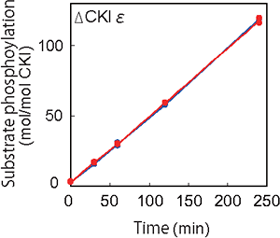Sep. 1, 2009 Press Release Biology
Central gears of the mammalian circadian clock exposed
The circadian clock, a 24-hour metabolic rhythm governing sleep cycles and other physiological processes, has long been known to play a central role in regulating the daily activities of living organisms. Its detailed biochemical mechanisms, however, have largely remained a mystery.
That mystery is one step closer to being unraveled with the latest discovery by a research team led by Hiroki R. Ueda of the RIKEN Center for Developmental Biology and Joseph S. Takahashi of Northwestern University, published in the Proceedings of the National Academy of Sciences. Researchers analyzed 1260 pharmacologically active compounds in mouse and human clock cell lines and identified 10 which exerted the greatest impact on the clock cycle. Surprisingly, all but one were found to target a single enzyme (casein kinase I ε/δ), the inhibition of which, researchers showed, dramatically extends this cycle from 24 hours to more than 48 hours.
That the circadian clock may be regulated by relatively simple processes involving only a handful of molecules, a possibility indicated by this result, overturns conventional thinking on the topic. The more important finding that the inhibition process identified is insensitive to changes of as much as 10 degrees celcius further hints at a breakthrough in the related puzzle of temperature compensation: how circadian clocks maintain constant periodicity over a broad range of temperatures.
Taken together, these findings suggest the need to fundamentally revise existing models of the mammalian circadian clock. They also point the way toward novel approaches to treatment of sleeping disorders and other debilitating clock-related conditions.
Contact
Hiroki.R. Ueda
Laboratory for Systems Biology
RIKEN Center for Developmental Biology
Tel: +81-(0)78-306-3191 / Fax: +81-(0)78-306-3194
Jens Wilkinson
RIKEN Global Relations and Research Coordination Office
Tel: +81-(0)48-462-1225 / Fax: +81-(0)48-463-3687
Email: pr [at] riken.jp

Figure 1: Circadian period is lengthened by chemicals
When TG003 and SP600125, strong inhibitors of CKIε/δ, were administrated to cultured mammalian cells at higher concentrations, the circadian period was lengthened from 24 hours to more than 48 hours.

Figure 2: Temperature-independent activity of CKIε/δ
Temperature dependency of the CKIε/δ phosphorylation activity for the PER2-peptide substrate was measured at 25°C (blue) and 35°C (red). CKIε/δ phosphorylated the peptide substrate at similar rates whether at 25°C or 35°C, indicating a strong temperature-insensitivity

Figure 3: Temperature-insensitivity of period and PER2 degradation
(left) Temperature dependency of decay of the mPER2::LUC bioluminescence in mPer2Luc MEFs.
(center) Temperature compensation in the half-lives of the mPer2::LUC protein.
(right) Temperature compensation in the period length of mouse embryonic fibroblast from mPer2Luc knock-in mice (mPer2Luc MEFs). The degradation rate of PER2, which is regulated by CKIε/δ-dependent phosphorylation, and the circadian period were temperature-insensitive in living clock cells.
